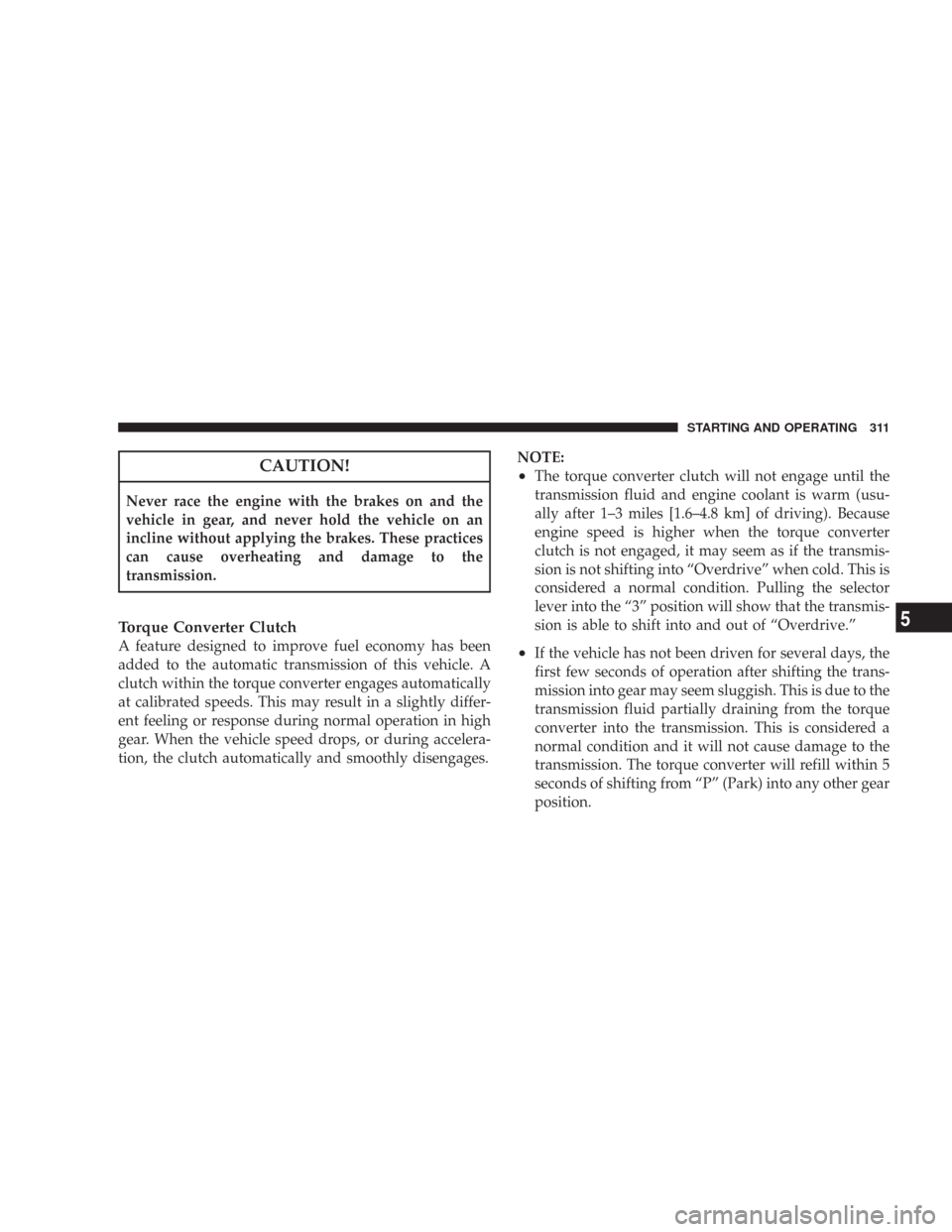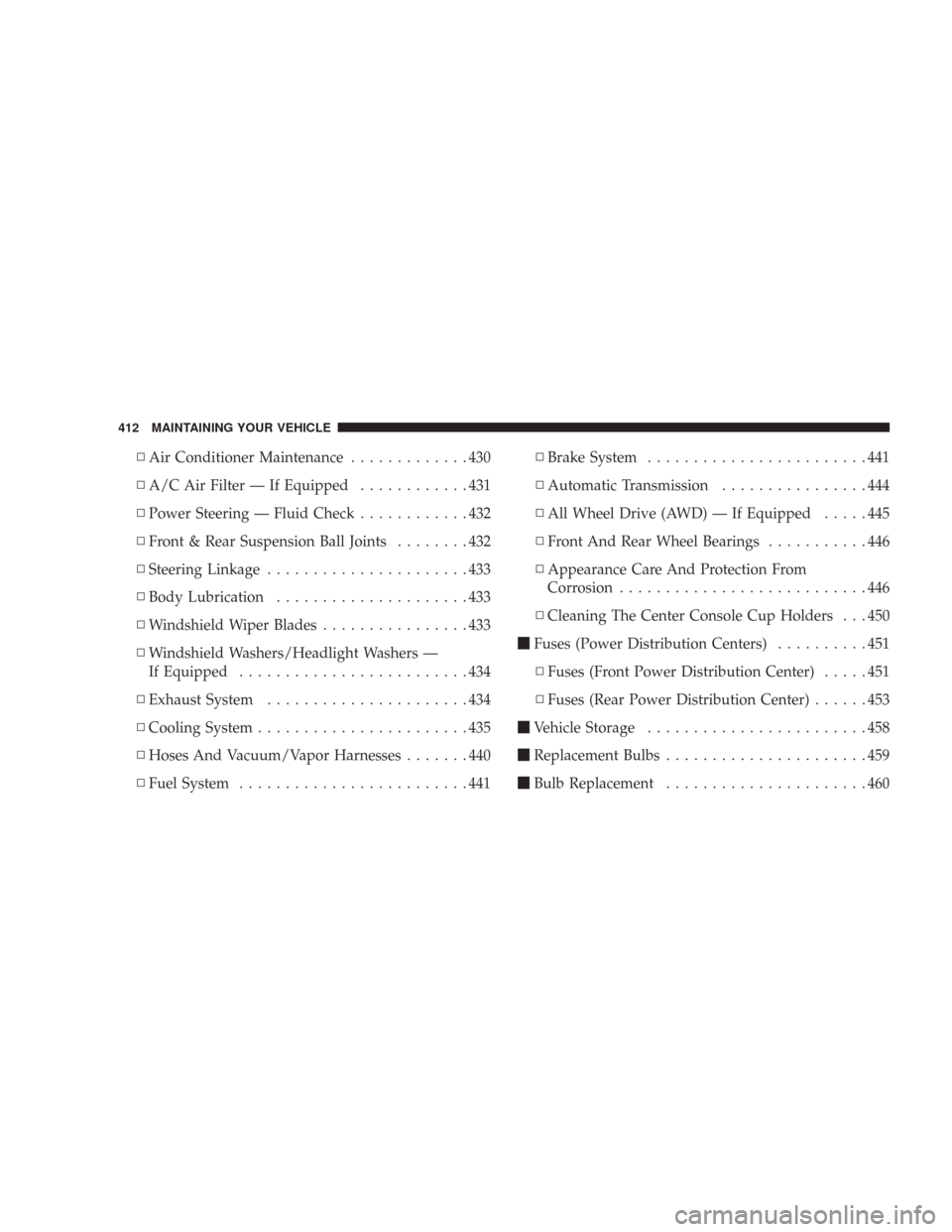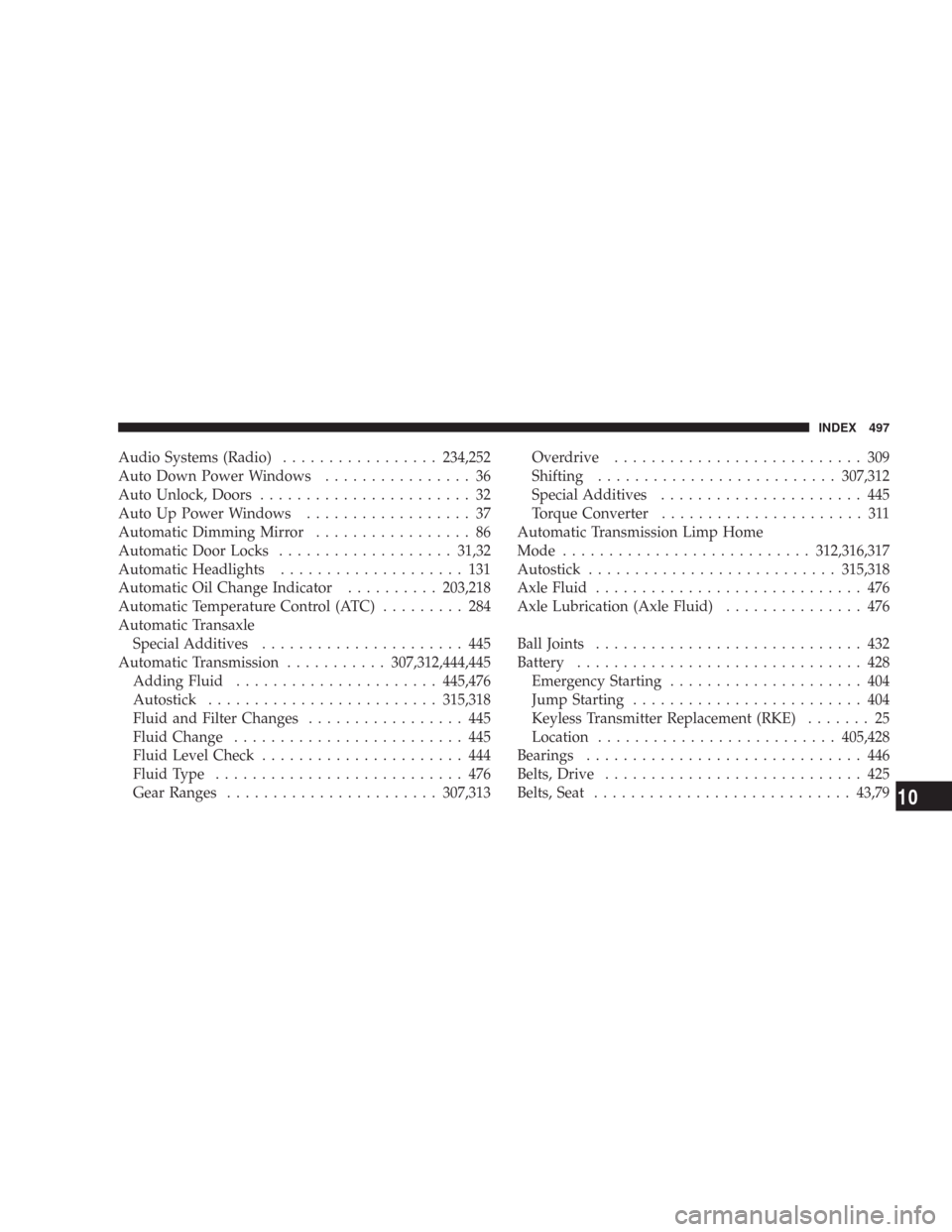automatic transmission fluid CHRYSLER 300 C 2008 1.G Owners Manual
[x] Cancel search | Manufacturer: CHRYSLER, Model Year: 2008, Model line: 300 C, Model: CHRYSLER 300 C 2008 1.GPages: 520, PDF Size: 5.43 MB
Page 312 of 520

CAUTION!
Never race the engine with the brakes on and the
vehicle in gear, and never hold the vehicle on an
incline without applying the brakes. These practices
can cause overheating and damage to the
transmission.
Torque Converter Clutch
A feature designed to improve fuel economy has been
added to the automatic transmission of this vehicle. A
clutch within the torque converter engages automatically
at calibrated speeds. This may result in a slightly differ-
ent feeling or response during normal operation in high
gear. When the vehicle speed drops, or during accelera-
tion, the clutch automatically and smoothly disengages.NOTE:
•The torque converter clutch will not engage until the
transmission fluid and engine coolant is warm (usu-
ally after 1–3 miles [1.6–4.8 km] of driving). Because
engine speed is higher when the torque converter
clutch is not engaged, it may seem as if the transmis-
sion is not shifting into “Overdrive” when cold. This is
considered a normal condition. Pulling the selector
lever into the “3” position will show that the transmis-
sion is able to shift into and out of “Overdrive.”
•If the vehicle has not been driven for several days, the
first few seconds of operation after shifting the trans-
mission into gear may seem sluggish. This is due to the
transmission fluid partially draining from the torque
converter into the transmission. This is considered a
normal condition and it will not cause damage to the
transmission. The torque converter will refill within 5
seconds of shifting from “P” (Park) into any other gear
position.
STARTING AND OPERATING 311
5
Page 389 of 520

Towing Tips
Before setting out on a trip, practice turning, stopping,
and backing the trailer in an area located away from
heavy traffic.
Towing Tips — Automatic Transmission
The “D” range can be selected when towing. However, if
frequent shifting occurs while in this range, the “3” range
should be selected.
NOTE:Using the “3” range while operating the vehicle
under heavy operating conditions will improve perfor-
mance and extend transmission life by reducing exces-
sive shifting and heat build up. This action will also
provide better engine braking.
If you REGULARLY tow a trailer for more than 45
minutes of continuous operation, then change the auto-
matic transamission fluid and filter according to the
interval specified for “police, taxi, fleet, or frequent trailer
towing” in the “Maintenance Schedule” in this manual.
Towing Tips — Electronic Speed Control (If
Equipped)
\25
Don’t use in hilly terrain or with heavy loads.
\25When using the speed control, if you experience speed
drops greater than 10 mph (16 km/h), disengage until
you can get back to cruising speed.
\25Use speed control in flat terrain and with light loads to
maximize fuel efficiency.
Towing Tips — Autostick\2(If Equipped)
\25
For vehicles equipped with Autostick.\2By using the
Autostick\2modes, and selecting a specific gear range,
frequent shifting can be avoided. The highest gear
range should be selected that allows for adequate
performance. For example, choose “4” if the desired
speed can be maintained. Choose “3” or “2” if needed
to maintain the desired speed.
388 STARTING AND OPERATING
Page 405 of 520

correct tightness of each lug nut is 100 ft/lb. (135 N. m).
If in doubt about the correct tightness, have them
checked with a torque wrench by your dealer or at a
service station.
7. For vehicles equipped with center caps, install the
center cap by hand. Do not use a hammer or excessive
force to install the center cap.
8. Stow the jack, tools, and spare tire. Make sure the base
of the jack faces the rear of the vehicle before tightening
down the fastener.
WARNING!
A loose tire or jack thrown forward in a collision or
hard stop could endanger the occupants of the ve-
hicle. Always stow the jack parts and the spare tire in
the places provided.
JUMP-STARTING PROCEDURES
WARNING!
•Take care to avoid the radiator cooling fan whenever the hood is
raised. It can start anytime the ignition switch is on. You can be hurt
by the fan.
•Do not attempt to push or tow your vehicle to get it started. Vehicles
equipped with an automatic transmission cannot be started this
way. Unburned fuel could enter the catalytic converter and once the
engine has started, ignite and damage the converter and vehicle. If
the vehicle has a discharged battery, booster cables may be used to
obtain a start from another vehicle. This type of start can be
dangerous if done improperly, so follow this procedure carefully.
•Battery fluid is a corrosive acid solution; do not allow battery fluid
to contact eyes, skin, or clothing. Don’t lean over battery when
attaching clamps or allow the clamps to touch each other. If acid
splashes in eyes or on skin, flush contaminated area immediately
with large quantities of water.
•A battery generates hydrogen gas, which is flammable and explo-
sive. Keep flame or spark away from the vent holes.
•Do not use a booster battery or any other booster source with an
output that exceeds 12 volts.
•The battery in this vehicle has a vent hose that should not be
disconnected and should only be replaced with a battery of the
same type (vented).
404 WHAT TO DO IN EMERGENCIES
Page 413 of 520

\3Air Conditioner Maintenance.............430
\3A/C Air Filter — If Equipped............431
\3Power Steering — Fluid Check............432
\3Front & Rear Suspension Ball Joints........432
\3Steering Linkage......................433
\3Body Lubrication.....................433
\3Windshield Wiper Blades................433
\3Windshield Washers/Headlight Washers —
If Equipped.........................434
\3Exhaust System......................434
\3Cooling System.......................435
\3Hoses And Vacuum/Vapor Harnesses.......440
\3Fuel System.........................441\3Brake System........................441
\3Automatic Transmission................444
\3All Wheel Drive (AWD) — If Equipped.....445
\3Front And Rear Wheel Bearings...........446
\3Appearance Care And Protection From
Corrosion...........................446
\3Cleaning The Center Console Cup Holders . . . 450
\1Fuses (Power Distribution Centers)..........451
\3Fuses (Front Power Distribution Center).....451
\3Fuses (Rear Power Distribution Center)......453
\1Vehicle Storage........................458
\1Replacement Bulbs......................459
\1Bulb Replacement......................460
412 MAINTAINING YOUR VEHICLE
Page 445 of 520

CAUTION!
Do not allow petroleum-base fluid to contaminate
the brake fluid. Seal damage may result.
Automatic Transmission
Fluid Level Check
Regular automatic transmission fluid level checks are not
required. For this reason, the dipstick is omitted.
If you notice fluid loss or gear shift malfunction, have
your authorized dealer check the transmission fluid level.
CAUTION!
•Using a transmission fluid other than the manu-
facturer’s recommended fluid may cause deterio-
ration in transmission shift quality and/or torque
converter shudder. Using a transmission fluid
other than that recommended by the manufacturer
will result in more frequent fluid and filter
changes. Refer to “Fluids, Lubricants, and Genu-
ine Parts” for the correct fluid type.
•The fluid level is preset at the factory and it does
not require adjustment under normal operating
conditions. If a transmission fluid leak occurs,
visit your authorized dealer immediately. Severe
damage to the transmission may occur. Your au-
thorized dealer has the proper tools to adjust the
fluid level accurately.
444 MAINTAINING YOUR VEHICLE
Page 446 of 520

Fluid and Filter Changes
Refer to the “Maintenance Schedule” in Section 8 of this
manual for the recommended transmission fluid and
filter change intervals.
If the transmission is disassembled for any reason, the
fluid and filter should be changed.
Special Additives
Automatic Transmission Fluid (ATF) is an engineered
product and its performance may be impaired by supple-
mental additives. Therefore, do not add any fluid addi-
tives to the transmission. The only exception to this
policy is the use of special dyes to aid in detecting fluid
leaks. In addition, avoid using transmission sealers as
they may adversely affect seals.
All Wheel Drive (AWD) — If Equipped
The all wheel drive system consists of a Transfer Case
and Front Differential. The exterior surface of these
components should be inspected for evidence of fluid
leaks. Confirmed leaks should be repaired as soon as
possible.
The transfer case fluid inspection plug is located in the
middle of the rear housing. To inspect the transfer case
fluid level, remove the inspection plug. The fluid level
should be even with the bottom of the hole. The transfer
case fill plug is located on the rear housing near the
output shaft.
The front differential fill plug is located on the outer
cover near the halfshaft attachment. To inspect the differ-
ential fluid level, remove the fill plug. The fluid level
should be even with or slightly below the bottom of the
hole.
MAINTAINING YOUR VEHICLE 445
7
Page 477 of 520

Component Fluids, Lubricants, and Genuine Parts
Oil Filter (3.5 Liter) Mopar\205281090 or equivalent.
Oil Filter (5.7 Liter) Mopar\205281090 or equivalent.
Fuel Selection (2.7 Liter) 87 Octane
Fuel Selection (3.5 Liter) 87 to 89 Octane
Fuel Selection (5.7 Liter) 87 to 89 Octane
Chassis
Component Fluids, Lubricants, and Genuine Parts
Automatic Transmission Mopar\2ATF+4 Automatic Transmission Fluid.
Brake Master Cylinder Mopar\2DOT 3, SAE J1703 or equivalent should be used. If DOT 3 brake
fluid is not available, then DOT 4 is acceptable. Use only recommended
brake fluids.
Front Axle API GL-5 SAE 75W90 Synthetic Gear Lubricant or equivalent.
Power Steering Reservoir Mopar\2Power Steering Fluid + 4, Mopar\2ATF+4 Automatic Transmission
Fluid.
Rear Axle API GL-5 SAE 75W140 Synthetic Gear Lubricant or equivalent.
Transfer Case Mopar\2Transfer Case Lubricant LX, P/N 05170055AA, or equivalent.
476 MAINTAINING YOUR VEHICLE
Page 483 of 520

Perform Maintenance Every(Where time and mileage
are listed, follow the interval that occurs first.)
Maintenance Items Miles Kilometers or Months
Inspect the transfer case fluid — All Wheel Drive
(AWD).30,000 50 000 30
Replace the spark plugs on 5.7L engines.30,000 50 000 30
Change the rear axle fluid if using your vehicle for
any of the following: police, taxi, fleet, off-road, or fre-
quent trailer towing.48,000 80 000 48
Change the automatic transmission fluid & filter if
using your vehicle for any of the following: police,
taxi, fleet, or frequent trailer towing.60,000 100 000 60
Change the transfer case fluid if using your vehicle for
any of the following: police, taxi, fleet, off-road, or fre-
quent trailer towing — All Wheel Drive (AWD).60,000 100 000 60
Inspect and replace the PCV valve if necessary.90,000 150 000 90
Flush and replace the engine coolant. 102,000 170 000 60
Replace the spark plugs on 2.7L and 3.5L engines.102,000 170 000 102
482 MAINTENANCE SCHEDULES
8
M
A
I
N
T
E
N
A
N
C
E
S
C
H
E
D
U
L
E
S
Page 484 of 520

Perform Maintenance Every(Where time and mileage
are listed, follow the interval that occurs first.)
Maintenance Items Miles Kilometers or Months
Replace the timing belt on 3.5L engines.102,000 170 000 102
Change the automatic transmission fluid & filter. 120,000 200 000 120
Replace the accessory drive belt on 2.7L engines. 120,000 200 000 120
WARNING!
You can be badly injured working on or around a
motor vehicle. Do only service work for which you
have the knowledge and the right equipment. If you
have any doubt about your ability to perform a
service job, take your vehicle to a competent
mechanic.
MAINTENANCE SCHEDULES 483
8
M
A
I
N
T
E
N
A
N
C
E
S
C
H
E
D
U
L
E
S
Page 498 of 520

Audio Systems (Radio).................234,252
Auto Down Power Windows................ 36
Auto Unlock, Doors....................... 32
Auto Up Power Windows.................. 37
Automatic Dimming Mirror................. 86
Automatic Door Locks...................31,32
Automatic Headlights.................... 131
Automatic Oil Change Indicator..........203,218
Automatic Temperature Control (ATC)......... 284
Automatic Transaxle
Special Additives...................... 445
Automatic Transmission...........307,312,444,445
Adding Fluid......................445,476
Autostick.........................315,318
Fluid and Filter Changes................. 445
Fluid Change......................... 445
Fluid Level Check...................... 444
Fluid Type........................... 476
Gear Ranges.......................307,313Overdrive........................... 309
Shifting..........................307,312
Special Additives...................... 445
Torque Converter...................... 311
Automatic Transmission Limp Home
Mode...........................312,316,317
Autostick...........................315,318
Axle Fluid............................. 476
Axle Lubrication (Axle Fluid)............... 476
Ball Joints............................. 432
Battery............................... 428
Emergency Starting..................... 404
Jump Starting......................... 404
Keyless Transmitter Replacement (RKE)....... 25
Location..........................405,428
Bearings.............................. 446
Belts, Drive............................ 425
Belts, Seat............................43,79
INDEX 497
10